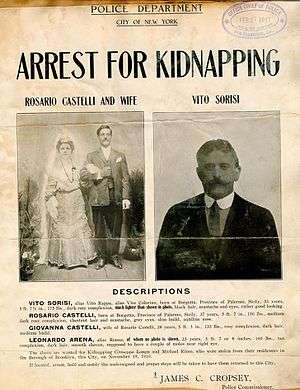Black Hand (extortion)

Black Hand (Italian: Mano Nera) was a type of extortion racket. It was a method of extortion, not a criminal organization as such, though gangsters of Camorra and the Mafia practiced it.
A June 1912 newspaper report in the New York Tribune stated that the Black Hand "...really exists only as a phrase. As an organization such a thing never existed out of the minds of the police. It is a catch phrase made famlliar through the newspapers, and the quick witted criminal of Latin extraction lost no time in using it as a nom de crime, which he wrote at the bottom of his blackmailing letters, sometimes - in fact, generally - adding fanciful decorations of his own, such as daggers dripping blood, revolvers spitting fire and bullets, crudely drawn skulls and crossbones and the inevitable sketch of a human hand."[1]
Origins
The roots of the Black Hand can be traced to the Kingdom of Naples as early as the 1750s. The English language term specifically refers to the organization established by Italian immigrants in the United States during the 1880s. A minority of the immigrants formed criminal syndicates, living alongside each other.
By 1900, Black Hand operations were firmly established in the Italian-American communities of major cities including New York, Philadelphia, Chicago, New Orleans, Scranton, San Francisco, Olean, NY and Detroit. In 1907, a Black Hand headquarters was discovered in Hillsville, Pennsylvania, a village located a few miles west of New Castle, Pennsylvania.[2] The Black Hand in Hillsville established a school designed to train members in the use of the stiletto.[2] Although more successful immigrants were usually targeted, possibly as many as 90% of Italian immigrants and workmen in New York and other communities were threatened with extortion.[2]
Typical Black Hand tactics involved sending a letter to a victim threatening bodily harm, kidnapping, arson, or murder. The letter demanded a specified amount of money to be delivered to a specific place. It was decorated with threatening symbols like a smoking gun, hangman's noose, skull, or knife dripping with blood or piercing a human heart, and was in many instances, signed with a hand, "held up in the universal gesture of warning", imprinted or drawn in thick black ink.[3]
Author/historian Mike Dash states "it was this last feature that inspired a journalist writing for The New York Herald to refer to the communications as "Black Hand" letters—a name that stuck, and indeed, soon became synonymous with crime in Little Italy."[3] The term "Black Hand" (in Italian: Mano Nera, and in Sicilian: Manu Niura) was readily adopted by the American press and generalized to the idea of an organized criminal conspiracy, which came to be known as "The Black Hand Society".[4]
The tenor Enrico Caruso received a Black Hand letter, on which a black hand and dagger were drawn, demanding $2,000. Caruso decided to pay, "and, when this fact became public knowledge, was rewarded for his capitulation with 'a stack of threatening letters a foot high,' including another from the same gang for $15,000."[3] Realizing the extortionists would continue to demand money, he reported the incident to the police who, arranging for Caruso to drop off the money at a prearranged spot, arrested two Italian-American businessmen who retrieved the money.
When law enforcement closed in, gangsters answered in their usual style—assassination. Victims include New Orleans police chief David Hennessy and NYPD lieutenant Joseph Petrosino.
References
- ↑ "Lupo the Wolf" Is Behind Bars, but Most of His Evil Whelps Are at Large, The New York Tribune, June 16, 1912
- 1 2 3 Watkins, John, The Big Stunts of Great Detectives: The Scrapbook, Vol. 4, No. 6, New York: Frank A. Munsey (December 1907), p. 1098
- 1 2 3 Dash, The First Family (Chapter 3, page 26)
- ↑ Dash, The First Family (Chapter 3, page 27)
Further reading
- Critchley, David (2008). The Origin of Organized Crime: The New York City Mafia, 1891-931. New York: Routledge.
- Dash, Mike (2009). The First Family: Terror, Extortion and the Birth of the American Mafia. London: Simon & Schuster. ISBN 978-1-84737-173-7.
- Lombardo, Robert M. (2004). "The Black Hand: A Study in Moral Panic". Global Crime (6:3-4).
- Pitkin, Thomas Monroe & Cordasco, Francesco (1977). The Black Hand: A Chapter in Ethnic Crime. Totowa, N.J.: Littlefield, Adams, & Co. (An excellent social historical study of the Black Hand during the early years of the twentieth century—when the influx of Italians was the greatest—using a variety of print sources.)
- Wallin, Geoff (July 3, 2007). "In Little Italy, Mum's the Word About Mob". Chi-Town Daily News.
- White, Frank Marshall (November 1917 – April 1918). "The Passing of the Black Hand". The Century Magazine. XCV.